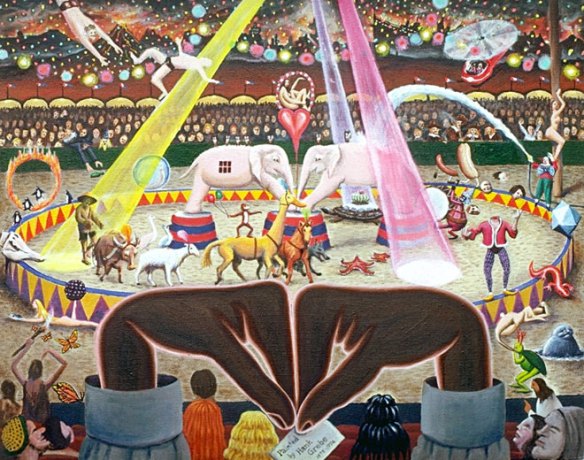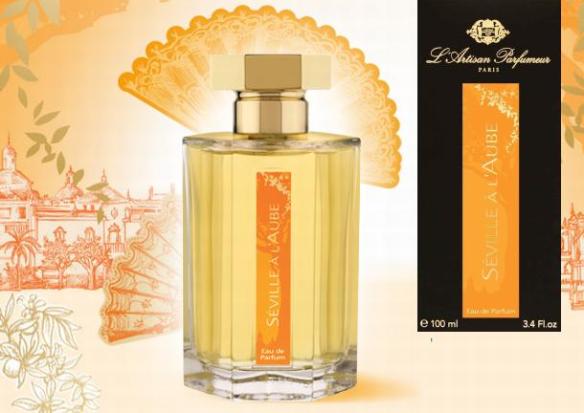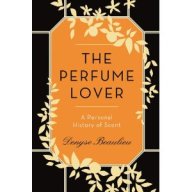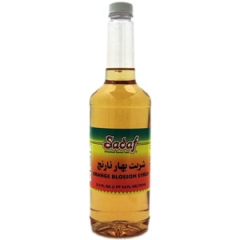A visit to a French patisserie that turns into a smoky, woody oriental vanilla — that’s the gist of Noir Exquis, the latest fragrance from Bertrand Duchaufour and L’Artisan Parfumeur. Large dollops of whipped pastry cream are squirted atop dark vanilla that is layered with candied chestnuts (marrons glacés), smokiness, and a profoundly tobacco-like note, all above a smoky sandalwood base. It’s actually quite nice at times (and less sweet than you might think), but it’s a fragrance that requires a little patience and some augmented quantities in order to see the traits that lie beyond an initial Tobacco Vanille vibe.
Category Archives: L’Artisan Parfumeur
Diptyque Florabellio & L’Artisan Parfumeur Rose Privee
I generally think that it’s a good idea for a perfume lover to go outside their comfort zone from time to time, and to stretch themselves by trying a different sort of olfactory style than what they are usually drawn to, so long as the scent in question has a few notes which they really love. Yet, even with that last part as a solid and absolute requirement, I usually end up wondering why I bothered, because the end result is almost invariably, inevitably, a failure. “Stretching oneself” seems to be great in theory, but actual perfume experimentation outside of my olfactory comfort zone — and, most particularly, amongst brands whose aesthetic I don’t enjoy — rarely results in a happy surprise or a miraculous find. More often than not, I’m left feeling greatly irritated.
That was the case with two new releases that I tried recently: Diptyque‘s Florabellio and L’Artisan Parfumeur‘s Rose Privée. Diptyque is not a brand whose aesthetic I enjoy, because I find their scents to be excessively synthetic, fresh, clean, and sheer, but Florabellio tempted me with claims of coffee, saltiness, and toasted sesame seeds. Hmmph. L’Artisan is another brand that rarely works for me, primarily due to synthetics, sheerness, and longevity issues, though I did really love the great, once discontinued Safran Troublant (which, alas, was also badly flawed by unusually brief longevity on my skin). Nevertheless, the new Rose Privée beckoned to me, not only because it was created by Bertrand Duchaufour, but also because it contains lilac, carnation, basil, patchouli, hay, and amber. What an intriguing set of elements to go with rose, I thought. It can’t be too bad. Well, it wasn’t the worst thing that I’ve ever tried; it had a few bits that were quite interesting or intriguing in the first hour; it was far from the rose soliflore that I was dreading; and it was an A/P scent that actually lasted on my skin for a change. Unfortunately, I also found it to be schizophrenic in its changes, and unappealing as a whole. I’ll cover each fragrance in turn.
Reviews en Bref: Dzing! and Dzongkha by L’Artisan Parfumeur
As always, my Reviews en Bref are for perfumes that — for whatever reason — didn’t seem to warrant a full, exhaustive, detailed analysis.
DZING!
 Dzing! is an eau de toilette fragrance from L’Artisan Parfumeur which seeks to evoke the circus. The woody scent was launched in 1999 and created by the highly respected perfumer, Olivia Giacobetti. The company describes it as follows:
Dzing! is an eau de toilette fragrance from L’Artisan Parfumeur which seeks to evoke the circus. The woody scent was launched in 1999 and created by the highly respected perfumer, Olivia Giacobetti. The company describes it as follows:
This shockingly unique fragrance, created by Olivia Giacobetti, Dzing! is a magical evocation of a circus of dreams and imagination. Everything is soft hued and slow moving, sights and sounds rolling by in the Big Top. Everything is there, the scent of saddle leather as pretty girls on horses canter by, sawdust, the rosin on the acrobats’ hands as they arc through the air, black panther fur, fire-eaters and gasoline, the vintage canvas overhead, the caramel scent of candyfloss and toffee apples. The circus as conceived by L’Artisan Parfumeur, comforting but contrasted with the occasional roar tearing through the night.
The most complete list of notes for Dzing! (which I shall call “Dzing” for the sake of convenience) comes from Fragrantica which mentions:
leather, ginger, tonka bean, musk, white woods, caramel, saffron, toffee, candy apple and cotton candy.
Dzing opens on my skin as rubbing-alcohol, candy apple. Seconds later, it explodes into a sharply synthetic cloud of artificial notes: white cotton candy fluff; dry dust; cheap leather; cheap caramel; cloying, cheap vanilla; and amorphous, cheap, synthetic gourmand notes. I’ve smelled better things a 99 Cent Store. I cannot imagine a scenario outside of testing where I’d wear Dzing for longer than a minute without shrieking.
The truly repellant aspect is in the revolting alcohol undertones and the cheap, pink, “Made in China” plastic aspect to all the artificial, laboratory-made notes. It’s as if the Mad Scientist infected the body of P.T. Barnum with a plan for world domination through olfactory torture. As the moments pass, the cheap Chinese, mass-produced, pink plastic note rises in prominence, as does the vanilla and the overall shrill cacophony of fakeness. This may be absolutely one of the worst things I’ve smelled in a while. I’m taken back to Tijuana, Mexico, and one of the cheap, tourist shops which sell tiny, plastic dolls, plastic shoes, and every possible hodge-podge of plastic tchotchkes. I wouldn’t object to a well-executed gourmand take on the smells of a circus, but the sheer deluge of cheap plastic and synthetics goes too far. Yes, I realise that almost every word out of my mouth includes the word “cheap” or “plastic,” but you have simply no idea how terrible Dzing smells. $145 for this? It would be easier to roll around naked on the industrial, synthetic carpeting in one of those 99 Cent stores that reek of fake vanilla, cheap apple-caramel candles, and, yes, PLASTIC.
Dzing must be a joke, right? Not a tongue-in-cheek, sweetly winking, happy, positive tease but, rather, a malicious, nefarious, completely sadistic joke created by an anti-social nihilist who intends to fumigate his victims while making a symbolic statement on the decline of Western civilisation, the corruption and decadence of capitalistic ventures like expensive perfumery, and the stupidity of those who think that the Emperor is wearing clothes. People, the Emperor is naked! NAKED! I’m not going to comment any further on this Ionesco-worthy, Absurdist, olfactory scheme to make me lose my mind.
DZONGKHA
Dzongkha is an eau de toilette fragrance created by Bertrand Duchaufour and inspired by the remote Buddhist mountain kingdom of Bhutan in the eastern Himalayas. L’Artisan describes it as follows:
Rich with aromatic influences: temple stones and incense, the sweet aroma of spiced chai tea, the heat of warm leather around fires, the heart of any temple or home in snowbound lands. Vetiver and green papyrus float through soft smoke with touches of peony, lychee and delicate iris. Dzongkha tells a special story on every skin: that of Dzongkha itself, the spiritual language of Bhutan.
On Fragrantica, Dzongkha is classified as a “woody spicy” fragrance and its notes are:
Top notes are peony, cardamom and litchi; middle notes are spices, white tea, vetiver, incense and cedar; base notes are leather, iris and papyrus.
Dzongkha opens with an unpleasant note of sharp incense. It’s not smooth, rich or soothing incense, but alcohol-like, bracing, and pungent. It is followed immediately by spices, predominantly cardamom, with what also feels like saffron, too. There are dry paper notes from the papyrus that evoke the feeling of an old book. Peony swirls in the background along with leather and tea notes.
The incense note is the key to much of Dzongkha’s early start. It is odd in its bracing bitterness and unbelievably desiccated. In combination with the papyrus, the overall effect is that of dust — whether a very old library or an abandoned church. Either way, it’s not enormously pleasant. Slowly, slowly, the cardamom heats up, warming the scent a little. Now, Dzongkha feels like cardamom-infused dust, atop a sharp, synthetic, incense note that burns a little. The whole thing is very airy, sheer and lightweight in feel, with low projection, and, yet, it is quite a strong scent in the beginning. I chalk it up to the synthetic undertone to the incense.
Thirty minutes in, Dzongkha has turned into cardamom dust with acrid incense, tea, spicy woods, and general earthy notes atop a growing base of leather. There is a light smattering of abstract florals flittering about in the background. The peony accord is muted and does little to alleviate the arid nature of the perfume. As time passes, the latter just gets worse and by the 90 minute mark, Dzongkha has turned into the most revoltingly bitter leather, vetiver and smoke fragrance. It is a veritable dust bowl of pungent, acrid dryness. At the same time, it also feels rancid and dark green — a bit like the moments in the legendary leather perfume, Bandit, from Robert Piguet with its deluge of sharply bitter, pungent galbanum and cold black leather. Yet, Dzongkha is a thousand times dryer, thanks to the incense note. I cannot believe how closely it replicates actual household dust, only in piles and heaps.
Dzongkha continues to change with time. By the start of the fourth hour, it is soapy, dark vetiver with bitter smoke, black leather and dust. It is still acrid and abrasively bitter — and I still can’t stand it. Midway into the fifth hour, the soapy element increases and takes on a sharply synthetic, dry, bitter incense accord. The combination smells extremely similar to that in another Bertrand Duchaufour incense creation for L’Artisan Parfumeur: Passage d’Enfer. I hated the latter, so I didn’t enjoy the overlap. In fact, my misery rose exponentially with every minute of Dzongkha’s sharply acrid, cloyingly soapy, painfully dust-like, and perpetually synthetic evolution. In its final moments, Dzongkha was just some amorphous soapy musk. All in all, it lasted 7 hours — all of them unpleasant, when they weren’t complete misery.
Testing Dzing and Dzongkha in the same day — even if the Dzing was only a few hours long — was an incredibly painful ordeal. For all that Dzing was mind-bogglingly terrible, it didn’t actually bring me down and make me feel low the way the incredibly unpleasant Dzongkha did. Really bad perfume experiences can feel almost oppressive, and Dzongkha certainly felt that way. I know it has its admirers, people who find its incense, spices and leather to be pleasant, even relaxing at times. All I can say is that I’m happy for you if it works. For myself, I’d like to forget this day entirely.
DETAILS:
Cost & Availability: Dzing and Dzongkha are both eau de toilette concentrations and cost $145, €95.00, or £78.00 for a 100 ml/ 3.4 oz bottle. Dzing is available on the L’Artisan website (where you can switch currency and sites from American to European) and Luckyscent. It should be available at Barneys, but I don’t see it listed on the website. In the UK, the L’Artisan line is carried at Harrods but I don’t see Dzing listed there. In Europe, it is available at First in Fragrance for €95. As for Dzongkha, it is available at the L’Artisan website, Luckyscent, and Barneys. In the UK, it is available at Harrods which also sells the smaller 50 ml size bottle. For the rest of Europe, it is available at First in Fragrance and other retailers. You can find a list of stores from Japan to Italy carrying L’Artisan products on the company’s Store Locator site. Samples are available at Surrender to Chance starting at $3.99 for a 1 ml vial for Dzing and Dzonghka.
Perfume Review: Seville à L’Aube by L’Artisan Parfumeur
There are perfumes that one should theoretically love but which, in reality, one simply cannot bear. Seville à L’Aube (Seville at Dawn) is one of those fragrances for me. A perfume that has sent the blogosphere into an utter tizzy, accompanied by a book of seemingly great sexiness, and a back-story of even greater romanticism, it is centered on one of my favorite notes: orange blossom. It is a perfume that would seem to be tailor-made for me. Ultimately, however, I couldn’t stand it. My personal perfume profile — and a particular note that I always struggle with — made Seville à L’Aube a very difficult experience for me.
Seville à L’Aube is a limited-edition eau de parfum released in 2012 and made for L’Artisan Parfumeur by the great Bertrand Duchaufour in conjunction with the writer and perfume blogger, Denyse Beaulieu of Grain de Musc. According to a quote from Ms. Beaulieu on Now Smell This, the perfume is supposed to represent one night in Seville and the start of a passionate affair between Ms. Beaulieu and her Spanish lover:
[Séville à l’aube] was inspired by one of the most beautiful nights in my life, in Seville during the Holy Week under an orange tree in full blossom, wrapped in incense smoke and the arms of a Spanish boy…
Fragrantica provides even more details on Ms. Beaulieu’s encounter:
I am in Seville, standing under a bitter orange tree in full bloom in the arms of Román, the black-clad Spanish boy who is not yet my lover. Since sundown, we’ve been watching the religious brotherhoods in their pointed caps and habits thread their way across the old Moorish town in the wake of gilded wood floats bearing statues of Christ and the Virgin Mary. […]
[The statue of the Madonna] is being carried into the golden whorls of a baroque chapel, smoothly manoeuvred in and out, in and out, in and out – they say the bearers get erections as they do this – while Román’s hand runs down my black lace shift and up my thigh to tangle with my garter-belt straps. […] I am in the pulsing, molten-gold heart of Seville, thrust into her fragrant flesh, and there is no need for Román to take me to bed at dawn: he’s already given me the night.
Bravo! If the story doesn’t leave one heated and intent on trying the perfumed encapsulation of that night, then I have no idea what will. I certainly was keen to test the perfume, and the blogosphere’s gushing, often poetic reviews only strengthening that determination.
Things seemed to have reached a crescendo this week with the U.S. release of Ms. Beaulieu’s book, The Perfume Lover: A Personal History of Scent, which describes, in part, the process of creating Seville à L’Aube with Mr. Duchaufour. (Apparently, the book also covers quite a bit of Ms. Beaulieu’s sex life, according to an article in The New York Times yesterday.)
I wasn’t aware that the book’s release was this exact week (and I hadn’t intended to cover the perfume until next week), but I have been feeling unwell lately, so I thought my beloved orange blossoms would be the perfect antidote and pick-me-up. It wasn’t until I read the perfume’s notes that a flicker of worry crossed my mind. The notes as compiled from Lucky Scent and Now Smell This include:
Orange blossom, lavender, pink pepper, petitgrain, lemon tree leaves, jasmine, magnolia, beeswax, incense, Benzoin Siam, Luiseiri lavender.
 You see, I really do not like lavender very much. I really, really do not. And Seville à L’Aube opens on my skin with a veritable tidal wave of dry, pungent, concentrated lavender, followed by bitter petitgrain and overwrought orange blossoms. I can tolerate lavender in small doses, but this degree of super-concentrated, intense lavender was well-nigh unbearable for me. It was akin to the most concentrated lavender oil, but with a particularly bitter, pungent, dry character. When combined with the equally bitter petitgrain (the distillation of the twigs from an orange blossom tree) and some incredibly peppery notes, the overall result passes into forcefully unpleasant territory.
You see, I really do not like lavender very much. I really, really do not. And Seville à L’Aube opens on my skin with a veritable tidal wave of dry, pungent, concentrated lavender, followed by bitter petitgrain and overwrought orange blossoms. I can tolerate lavender in small doses, but this degree of super-concentrated, intense lavender was well-nigh unbearable for me. It was akin to the most concentrated lavender oil, but with a particularly bitter, pungent, dry character. When combined with the equally bitter petitgrain (the distillation of the twigs from an orange blossom tree) and some incredibly peppery notes, the overall result passes into forcefully unpleasant territory.
The orange blossoms weren’t my salvation, either. Sometimes, orange blossoms can impart a faintly soapy undertone but — though there was just a hint of that here in the opening moments — the real issue for me was the impact of the other notes. They turned the orange blossom into something extremely dry with a definitely pungent, woody, almost herbaceous, peppery twist. There is some relief from the sweet magnolia flower which adds a soft, velvety, plush floral note with some fruity nuances — but not much. At this stage, it is predominantly lavender, bitterness, dryness, more lavender, and orange blossom.
Fifteen minutes later, the overpowering lavender has started to meld a little better with the orange blossom. The notes turn into one spicy-sweet accord with some pungent green notes, but it’s still an ordeal and I still struggle. As time passes, the lavender starts to recede a little, the orange blossom takes the lead and the perfume turns much sweeter.
Except now, it is too sweet. Revoltingly so. I’m having strong flashbacks to Tom Ford‘s Neroli Portofino which I found to be a similarly excessive, cloyingly sweet, orange blossom scent. It’s as though the flower has been put on steroids, in both perfumes. And, frankly, there is something very unnatural and artificial about the extremeness. I am strongly reminded of the thick, concentrated orange blossom syrup used in Middle Eastern desserts — but amped up with aromachemicals. Just as with Neroli Portofino, Seville à L’Aube makes me feel physically queasy. (Perhaps I can’t handle perfumes that are essentially orange blossom soliflores?)
My intense queasiness and nausea continue for quite a long time, leaving me wondering if I shouldn’t just save myself and scrub this off. To be honest, the first time I tried Seville à L’Aube, I completely gave up but, since I had an appointment I couldn’t miss at the vet, I simply sprayed another perfume over it to be free of it.
The second time, however, I persevered and, around the 2.5 hour benchmark, the perfume finally became less of an ordeal. That unnatural, extreme and painfully cloying sweetness starts to slowly dissipate. Somewhat. The lavender has — thank God — retreated for the most part, to be replaced by a quiet note of beeswax and vanilla benzoin. Soft touches of jasmine lurk behind the orange blossom and there is also the advent of a subtly smoky base, though the incense is never more than a faint shimmer in the background. From the start, the perfume has always been incredibly airy and lightweight in feel, though also surprisingly strong and powerful. Now, near the 3 hour mark, it finally drops in sillage and power. It is still, however, far too sweet for my liking.
For the next seven hours, the perfume is predominantly orange blossom with some light vanillic benzoin. It’s an incredibly persistent, long-lasting scent. It’s not completely terrible; there are times when I even think I may like it. Then I remember that brutal opening — and shiver. I could never go through that again, but I fully recognise that my reaction is due to my own personal discomfort with some notes. That said, I really do think that the perfume is overly sweet by more than just my standards. I made two people sniff my arm, and both thought the same thing with one actually recoiling in aversion.
We’re not alone in that conclusion, though we are in the minority. Bloggers may generally (with some exceptions) adore Seville à L’Aube, but the reaction from general commentators is distinctly more mixed. On Fragrantica, a number of people mention the “cloying” nature of the perfume or how it is “a little nauseating.” (See, it’s not just me!) On Luckyscent, some of the reviews are equally unenthused:
- urgh, not sure how I feel about this. Lots of orange blossom. Gives an impression of orange and green. It’s somehow too much, has a weird gourmand quality, like a big too-sweet meringue covered in candied flowers and orange leaves. Also a tiny trace of celery.
- I so eagerly awaited a decant, only to discover this smells uncannily like Fruity Pebbles. The opening (as much as I could ascertain with my sample) is smoky and sexy with the sweetness of orange blossom but the dry down is straight Fruity Pebbles. I was really hoping for smoky holy days and my garters getting tangled.
- I get a lot if benzoin in this one, and the same rooty, astringent carrot from Nuit de Tubereuse. The orange blossom note has a burned sugariness to it, so that it isn’t airy, but syrupy. Definitely a fall perfume.
- The opening is a lively orange blossom composition with some unusual notes. But that lasts only a few minutes. The drydown is a sweet, fairly generic orange blossom cologne. It’s gone completely in 45 minutes on my skin, according to my housemates. There is one note in common with Nuit de Tubereuse that actually sears my nose briefly. No idea what the aromachemical is, but it can be a bit painful.
Oddly, there are a number of comparisons on the Luckyscent reviews to Nuit de Tubereuse which is also from Bertrand Duchaufour and L’Artisan Parfumeur. I couldn’t stand that one, truth be told, but I can’t see the similarities unless it’s in the area of unpleasant aromachemicals. I think Seville à L’Aube is a much better scent, relatively speaking — though given my feelings about Nuit de Tubereuse, I’m not sure that’s saying much.
I should also add that I know others who do not have issues with lavender but who, nonetheless, struggled with Seville à L’Aube. Some found it painfully dry at the start. A few found it “sour,” like my friend and fellow perfume blogger, The Scented Hound, who also described the perfume as “a cross between floor cleaner and sour shampoo,” and called it “purgatory.” One blogger, Almost au Naturel, suffered entirely different notes, summing up the scent as “funky, sexed up baby powder.” Though she ended up appreciating Seville à L’Aube for what it was, she begged people not to fall for the hype.
I definitely agree with that last conclusion. Don’t let the hype lead you to unrealistic expectations. If you love lavender, orange blossom and very sweet perfumes, then Seville à L’Aube may be one for you to consider. (However, the perfume is limited-edition and, with the advent of the U.S. edition of the book, it is even hotter than it was before, so I suggest you test it out very soon if you want to try to obtain a bottle.) For those who are less than enamoured of those notes, however, it may be “purgatory” and you might want to stick with reading the book.








